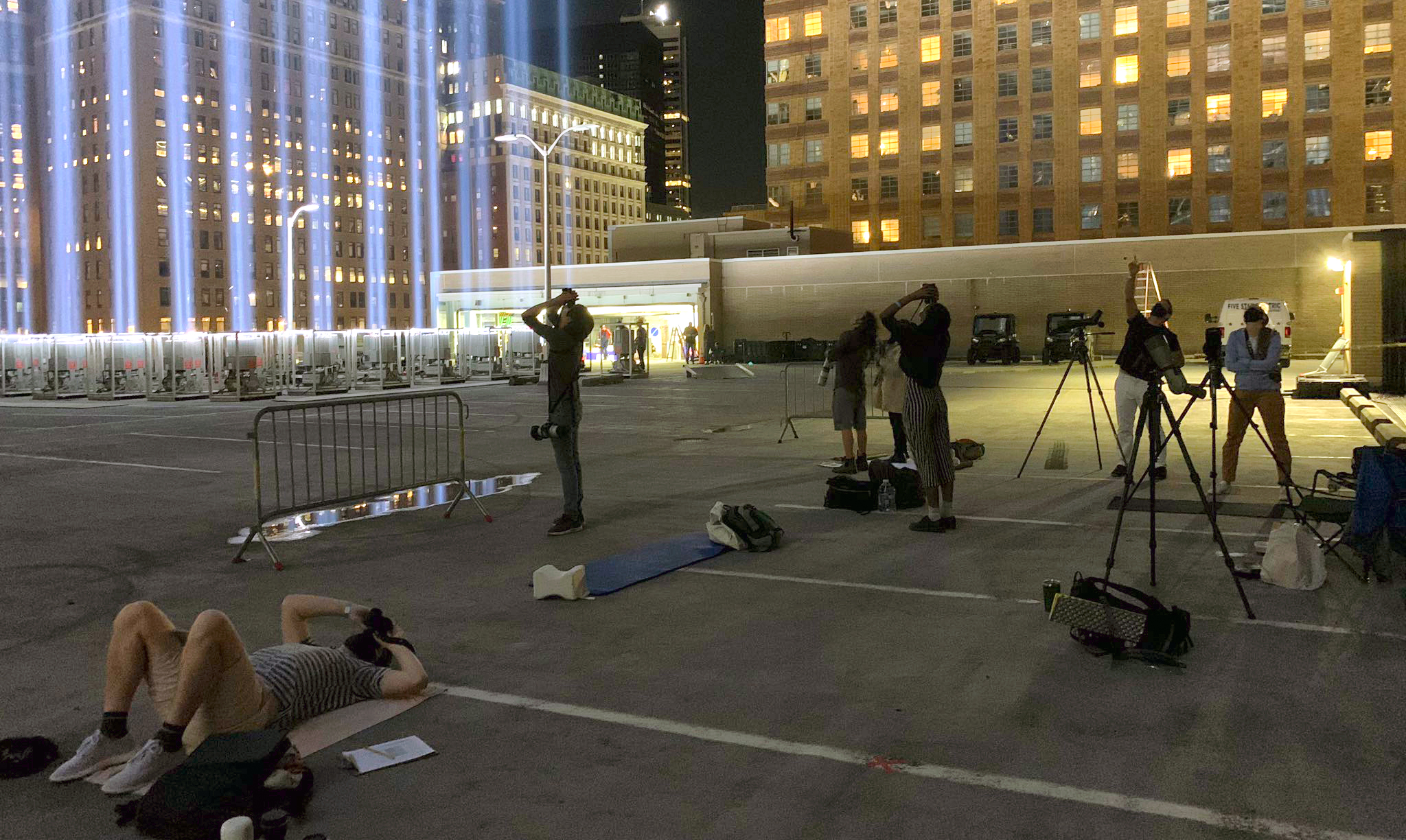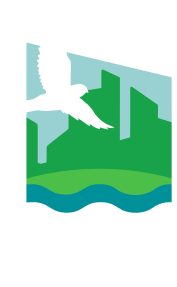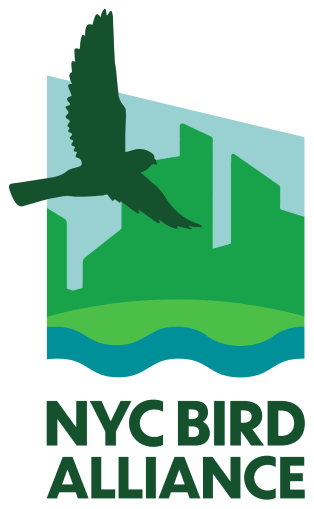Recapping the 2020 Tribute in Light Monitoring
category: VOLUNTEER!CONSERVATION

Kaitlyn Parkins | Sep 25, 2020
On the 19th anniversary of the September 11 terrorist attacks, four beams of light shone into the sky in memorial of those whose lives were tragically lost on that day. Two of those beams were at the Tribute in Light Memorial in New York City, representing the Twin Towers. Two new Tributes also brightened the sky this year: one in Shanksville, PA, memorializing the heroes on board Flight 93, and one at the Pentagon in Washington, DC.
In addition to monitoring the tribute in New York City this year, NYC Bird Alliance staff and our colleagues at the Cornell Laboratory of Ornithology provided resources and advice to the organizations and individuals monitoring the other two sites. The new installations presented us with a valuable research opportunity, as the sites are each unique in terms of location, migration density, and environmental variables. Our hope is to use data collected at all three sites to learn more about the effect of artificial light on bird behavior and how these other factors play a role.
Like most things in 2020, our Tribute in Light monitoring on the parking garage roof in lower Manhattan looked a little different this year. This year we brought a much scaled-down team of NYC Bird Alliance volunteers and staff and used extra safety precautions to conduct a socially distanced monitoring event. A small team of eight staff and volunteers was present, many of whom stayed up all night. We donned masks, didn’t share equipment, and counted birds from six-feet apart.
Bird migration, of course, has been unaffected by the pandemic. Leading up to the night of 9/11, we were regularly checking BirdCast, which predicted “medium” migration intensity. When asked if that was good or bad by a Tribute production team staffer, Dr. Andrew Farnsworth, Cornell Lab of Ornithology Senior Research Associate and NYC Bird Alliance advisory council member, answered, “well, it’s not high, but it’s not low.” We just had to wait and see how the night would go.
Our agreement with partners National September 11 Memorial & Museum and Michael Ahern Production Services calls for the lights to be turned off when necessary to allow migratory birds that are disoriented in the beams to disperse. (Learn more about our Tribute in Light monitoring program and the scientific insights we have gained from the Tribute in this Sierra article here.) The Tribute in Light organizers and production team are always respectful of our requests, and we thank them for continuing to work with us to ensure the Tribute in Light is safe for our night-migrating birds.
Shortly after sunset, migration picked up. Birds were coming through at higher than typical densities for that early hour and we were getting concerned. Volunteers tracked the numbers of birds in the beams every 20 minutes while the Cornell Lab team checked the radar and recorded night flight calls. As birds began to concentrate in the beams between 11:30pm and midnight, the team from Michael Ahern Production Services was prepared to shut off the lights. Within minutes, however, the birds began to disperse without the lights needing to be turned out. The number of birds in the beams remained low for the remainder of the night, and for the first time in several years, the Tribute beams stayed on for the entire night.
In between counts, the team identified some of the birds passing through. American Redstarts, Black-and-white Warblers, and Yellow Warblers were common. A Connecticut Warbler made an appearance, as did a Hooded Warbler. Several Common Nighthawks and a hunting Peregrine Falcon were also spotted.
Birds weren’t the only wildlife present. Eastern Red Bats fluttered overhead, hunting the many insects trapped in the beams. Volunteer Doug Gotchfeld photographed and identified a Black Witch Moth, a species common in the Southern U.S. but uncommon in New York. You can see Doug’s iNaturalist report here. Monarch butterflies were also seen in the beams; while common in NYC, especially during migration, they are not a typical sight during the Tribute monitoring. One of them was captured and released by Doug the next day in Coney Island, to carry on with migration.
Check out our twitter feed and instagram stories for updates and photos from the night.
-Kaitlyn Parkins, Senior Conservation Biologist
On the 19th anniversary of the September 11 terrorist attacks, four beams of light shone into the sky in memorial of those whose lives were tragically lost on that day. Two of those beams were at the Tribute in Light Memorial in New York City, representing the Twin Towers. Two new Tributes also brightened the sky this year: one in Shanksville, PA, memorializing the heroes on board Flight 93, and one at the Pentagon in Washington, DC.
In addition to monitoring the tribute in New York City this year, NYC Bird Alliance staff and our colleagues at the Cornell Laboratory of Ornithology provided resources and advice to the organizations and individuals monitoring the other two sites. The new installations presented us with a valuable research opportunity, as the sites are each unique in terms of location, migration density, and environmental variables. Our hope is to use data collected at all three sites to learn more about the effect of artificial light on bird behavior and how these other factors play a role.
Like most things in 2020, our Tribute in Light monitoring on the parking garage roof in lower Manhattan looked a little different this year. This year we brought a much scaled-down team of NYC Bird Alliance volunteers and staff and used extra safety precautions to conduct a socially distanced monitoring event. A small team of eight staff and volunteers was present, many of whom stayed up all night. We donned masks, didn’t share equipment, and counted birds from six-feet apart.
Bird migration, of course, has been unaffected by the pandemic. Leading up to the night of 9/11, we were regularly checking BirdCast, which predicted “medium” migration intensity. When asked if that was good or bad by a Tribute production team staffer, Dr. Andrew Farnsworth, Cornell Lab of Ornithology Senior Research Associate and NYC Bird Alliance advisory council member, answered, “well, it’s not high, but it’s not low.” We just had to wait and see how the night would go.
Our agreement with partners National September 11 Memorial & Museum and Michael Ahern Production Services calls for the lights to be turned off when necessary to allow migratory birds that are disoriented in the beams to disperse. (Learn more about our Tribute in Light monitoring program and the scientific insights we have gained from the Tribute in this Sierra article here.) The Tribute in Light organizers and production team are always respectful of our requests, and we thank them for continuing to work with us to ensure the Tribute in Light is safe for our night-migrating birds.
Shortly after sunset, migration picked up. Birds were coming through at higher than typical densities for that early hour and we were getting concerned. Volunteers tracked the numbers of birds in the beams every 20 minutes while the Cornell Lab team checked the radar and recorded night flight calls. As birds began to concentrate in the beams between 11:30pm and midnight, the team from Michael Ahern Production Services was prepared to shut off the lights. Within minutes, however, the birds began to disperse without the lights needing to be turned out. The number of birds in the beams remained low for the remainder of the night, and for the first time in several years, the Tribute beams stayed on for the entire night.
In between counts, the team identified some of the birds passing through. American Redstarts, Black-and-white Warblers, and Yellow Warblers were common. A Connecticut Warbler made an appearance, as did a Hooded Warbler. Several Common Nighthawks and a hunting Peregrine Falcon were also spotted.
Birds weren’t the only wildlife present. Eastern Red Bats fluttered overhead, hunting the many insects trapped in the beams. Volunteer Doug Gotchfeld photographed and identified a Black Witch Moth, a species common in the Southern U.S. but uncommon in New York. You can see Doug’s iNaturalist report here. Monarch butterflies were also seen in the beams; while common in NYC, especially during migration, they are not a typical sight during the Tribute monitoring. One of them was captured and released by Doug the next day in Coney Island, to carry on with migration.
Check out our twitter feed and instagram stories for updates and photos from the night.
-Kaitlyn Parkins, Senior Conservation Biologist


